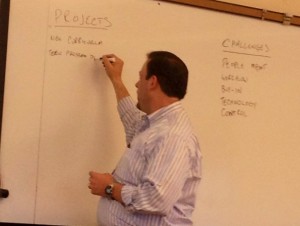- Why Wing It? Project Management Training
- Financial Literacy for Non-Financial Professionals
- Facilitate Fruitful, Faster and Fun Project Meetings
- Facilitate Effective, Engaging Teleconferences
Why Wing It? Project Management Training
Project Management has come a long way since the days of worrying about getting that call from the corner office informing you that you have been selected for the “opportunity” to manage the next big project. Most professionals in your organization are involved in managing projects, but chances are, very few of them have had training in the soup-to-nuts skills required to see a project through successfully from beginning to end. The risks of “winging it” and hoping for a positive result are monumental to the project, the organization, and the people involved. The adage promoted by Bob Vila – measure twice, cut once – is applicable to project management and will significantly reduce your risks and increase the likelihood of success.
 Would you rather them learn solely through trial and (possibly very costly) error – or get the knowledge, skills and attitudes they need to hit the ground running on their very next project?
Would you rather them learn solely through trial and (possibly very costly) error – or get the knowledge, skills and attitudes they need to hit the ground running on their very next project?
Whether you want to reinforce the PM skills of your senior leaders, make sure that your mid-level managers are on target, or introduce the concepts to your up-and-comers, our training is customized to meet the unique needs of your group and company.
Topics include:
Mastering The Project Lifecycle (Planning, Executing, and Closing)
• Getting started and maintaining positive momentum
• Understanding the goals and objectives
• Establishing your execution plan
• Developing your key performance indicators (KPIs)
• Identifying potential risk to success
Mastering Project Controls (Budget, Time and Quality)
• Selecting the critical project controls elements
• Understanding the relationships between cost, schedule and quality
• Establishing tools and milestones to effectively monitor the progress.
Mastering Teamwork and Collaboration on any Project
• Maximize your team’s potential
• Creating and managing client expectations
• Developing an open communications plan
• Understanding the importance of accountability and responsibility
• Defining roles and expectations for all team members
“Michael Riegel’s innate skill at simplifying complex technical projects, his deep understanding of business operations, and his exceptional ability to motivate staff makes him an invaluable consultant for technical organizations. These skills paired with his genuine personality and easy-going style made Michael a pleasure to work with. Michael is the type of consultant that challenges the status quo in a positive way and helps organizations achieve win-win situations. He defies the stereotype of the consultant by demonstrating his investment in identifying and implementing long-term, sustainable solutions and in developing lasting relationships throughout the levels of the organization.”
Walter Gross, Vice President
Tectonic Engineering
Financial Literacy for Non-Financial Professionals
When your staff hears about balance sheets, income statements, and cash flow, do their eyes glaze over? If so, then this course is essential to help non-financial professionals understand the basics of financial literacy, accounting and budgeting that will allow them to more effectively manage their project’s bottom line and communicate confidently with financial professionals.
Using the Color Accounting approach, learning is hands-on, engaging and very quick. The Color Accounting methodology is so simple that anyone can conquer the language of business.
(Just imagine the costs if they don’t.)
This session will help you:
• Understand the context and need for financial literacy
• Learn key accounting components and language
• Record business transactions with ease and efficiency
• Compile financial statements, including balance sheets, income statements and cash flow statements
• Interpret the business story told by a set of accounts
• Gain business acumen basics
• Avoid common pitfalls in financial communication
Facilitate Fruitful, Faster and Fun Project Meetings
More data dumping than strategic thinking? More opinions than outcomes? More food than facilitation? It must be a project meeting! Every time you hold an internal or external meeting, you have the opportunity to re-engage staff in the business objectives of the organization, plan and accomplish critical tasks, build ownership, retain talented professionals, reinforce supportive personal and professional relationships, and demonstrate that your company knows how to get things done. So, how many of these opportunities are you missing? If your project meetings with are unproductive, unfocused or unpopular – this session is for you.
This session will help you:
• Understand and consistently meet the three criteria for productive meetings.
• Use meetings to get work done rather than to avoid “real” work.
• Identify (and cancel!) unnecessary meetings.
• Consistently start and end meetings on time.
• Model, reward and reinforce constructive meeting behaviors.
• Build a time-sensitive, outcome-based agenda that drives the entire meeting.
• “Backseat Drive” a meeting with a weak facilitator.
• Reinforce your organization’s core values, mission and vision in meetings.
• Identify and adapt to different communication needs among participants.
• Facilitate to energize, invigorate and rejuvenate your meetings.
Facilitate Effective, Engaging Teleconferences
While face-to-face is usually ideal for meetings, it’s often an unrealistic expectation when teams or clients are off-site, time is tight, and travel is not in the budget. For teleconferences and other virtual meetings, even the strongest face-to-face meeting facilitator needs new skills to tap into the best thinking of a remote group as efficiently and effectively as possible, while keeping everyone engaged and focused on shared outcomes. In this “blended” session of live instructor-led training and remotely facilitated teleconferences, you will learn the unique skills needed to facilitate and participate in remote meetings, and how to expertly design and facilitate telephone meetings that ensure maximum participant effectiveness.
This session will help you:
• Identify when meetings can be remote vs. when they must be in-person..
• Prepare for the unique needs of virtual meetings before the meeting is called.
• Determine the level of interaction needed for 6 different meeting types.
• Establish and achieve meeting objectives.
• Use visual tools to increase participation.
• Build social capital to increase collaboration.
• Build dynamic and directive time-sensitive agendas that help drive the meeting.
• Institute, communicate and model remote meeting etiquette.
• Use pre- and post-meeting activities and instructions to keep calls focused.
• Plan transitions between speaking, writing, listening and other call-related activities.
• Track deliverables, develop and deliver action plans

